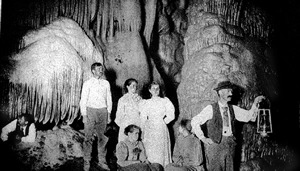at Onondaga Cave State Park
| Photo by John Eaton, ca. 1895 |
 |
Prior to the arrival of the European settlers, caves were important shelters for the Native Americans. They used caves that had dry floors and large openings (where smoke from campfires could not collect) for shelter and for dwellings. American Indians used several caves along the Meramec River, but they seldom went beyond the entrances. The natural entrance to Onondaga Cave is low and water filled; it was probably never used by Native Americans.
Several caves exist along the Meramec River. Being proximal to water, some were likely used by Native Americans. It remains unknown if Onondaga Cave was ever used by any Indigenous peoples. To date, no evidence of prehistoric use has been identified. Because the natural entrance to Onondaga Cave is water filled and situated in the flood plain its location may have been less appealing. However, caves had special significance for Native Americans. It is certainly possible that Onondaga, or any of the caves located in the park, could have been used in ways that did not leave tangible remains, perhaps as a spiritual or ceremonial location. For example, the Osage Nation, descendants of the prehistoric inhabitants of the Meramec River area, have recognized Onondaga Cave as one of many sacred sites in Missouri. The combination of water and cave has a very powerful meaning to the Osage and the ancestral people who would have considered Onondaga Cave a significant part of the landscape.
The early European settlers used caves to protect and feed themselves. They mined the mineral saltpeter from the caves. Saltpeter was used in making gunpowder and comes from the nitrates in the cave clay reacting with the rock to make calcium nitrate. The nitrates in the clay came from either bat excrement or nitrogen fixing bacteria in the clay. The saltpeter was extracted from the clay and refined; then it was mixed with potash to make potassium nitrate and lime.
Caves supplied the early settler with gunpowder for hunting and for protection from American Indians and outlaws. Caves in Missouri were also an important source of saltpeter during the War of 1812 and the Civil War. The Union army got its supply of gunpowder from elsewhere, but the caves were mined for saltpeter to supply the Confederate army. Today, other ways of making gunpowder have replaced saltpeter mining. Onondaga Cave itself was never used for gunpowder, as it remained undiscovered until after the time when caves were so used. As settlement continued, some of the springs, which came out of caves, were dammed to power gristmills. A gristmill was the place where people took their corn and wheat to be ground into meal and flour. The Davis Mill foundation can still be seen outside of Onondaga Cave.
Caves also played a role in the development of a major industry in St. Louis; the brewing of beer. Before the invention of refrigeration, the only place that a brewery could lager beer was in cool caves. Missouri's caves, at a constant temperature of about 56°F (13°C ), were a perfect place to lager beer. Beer was first introduced into the United States in 1840; by 1860 there were 40 breweries in St. Louis, each with its own cave.






